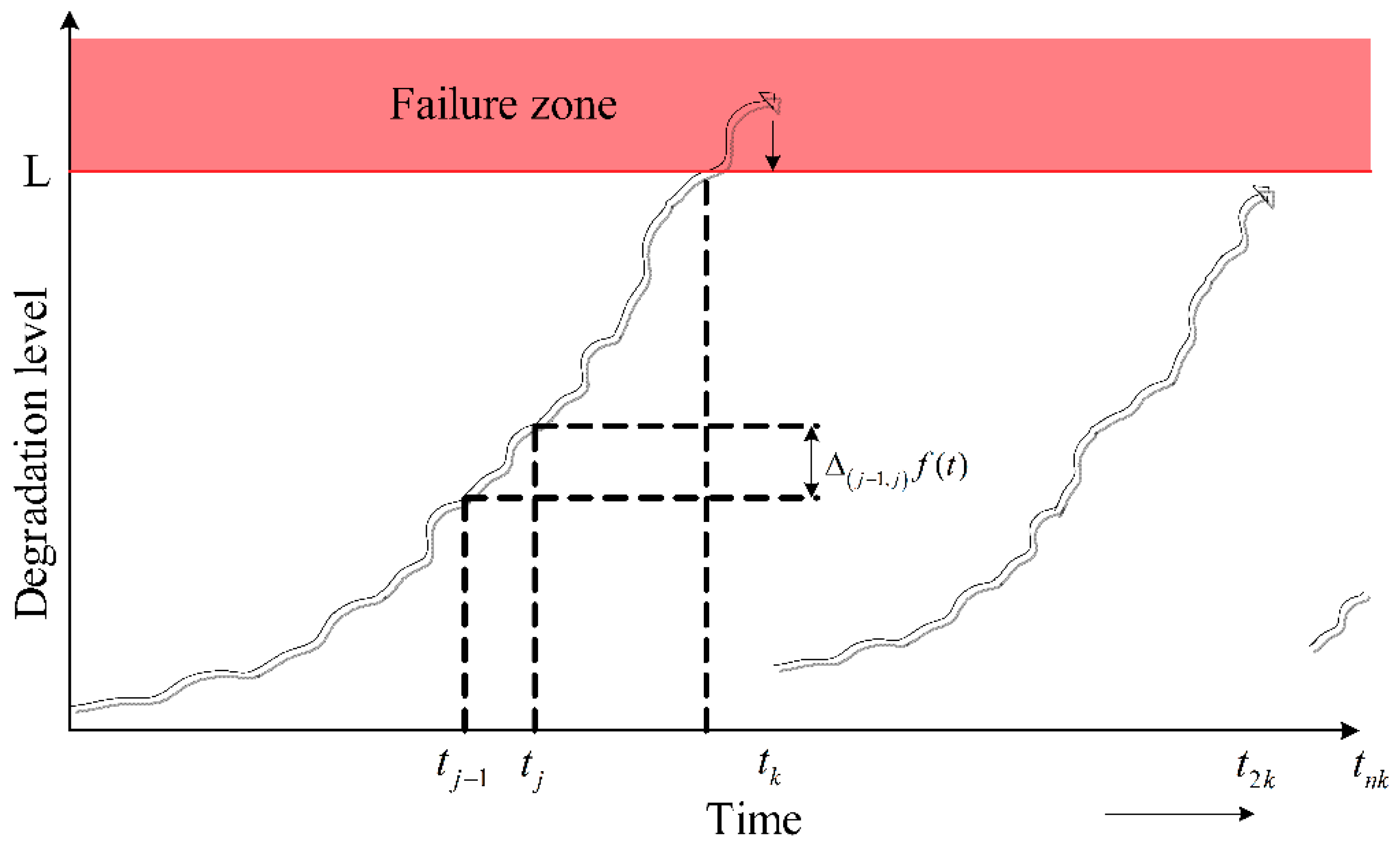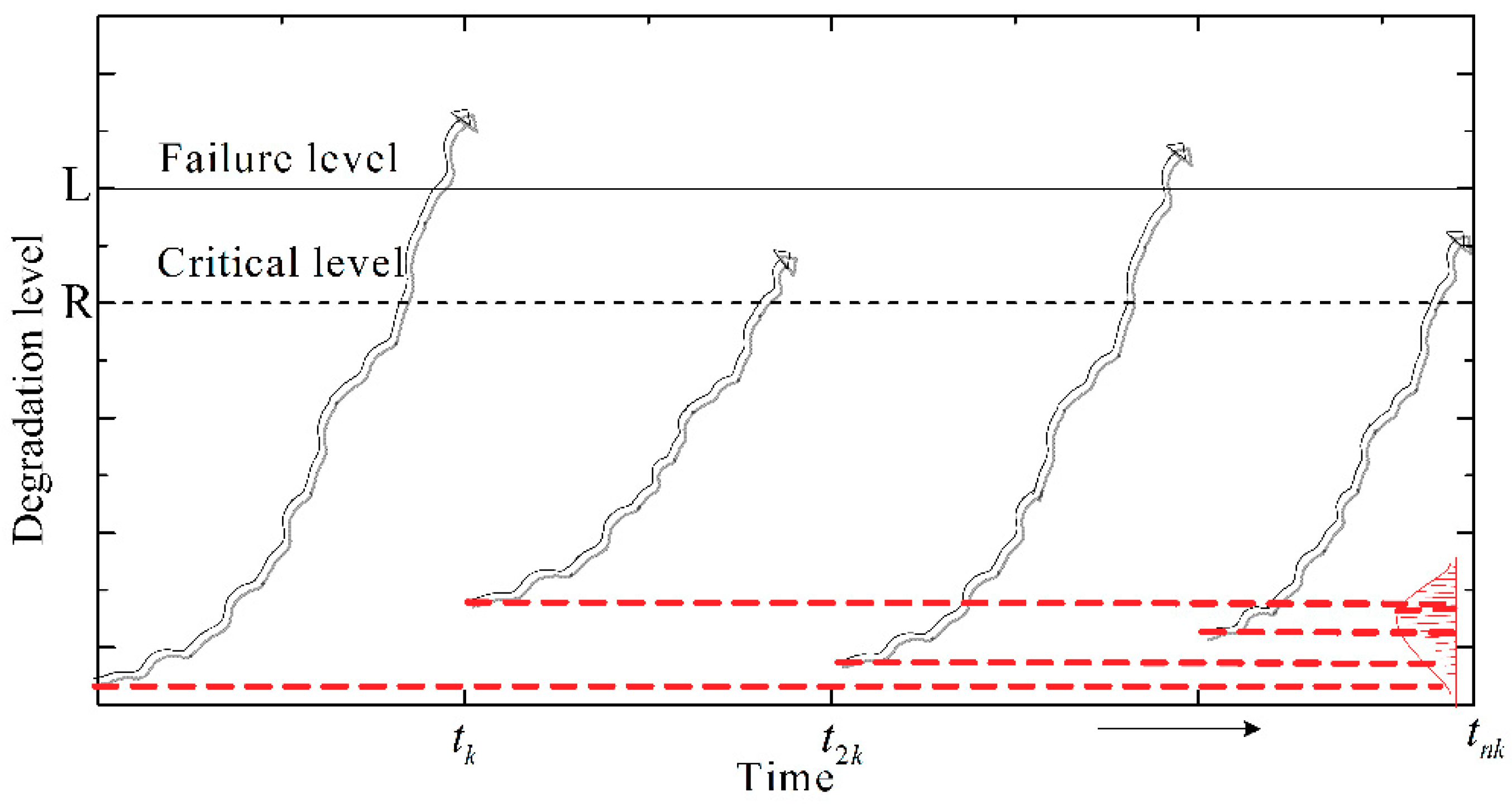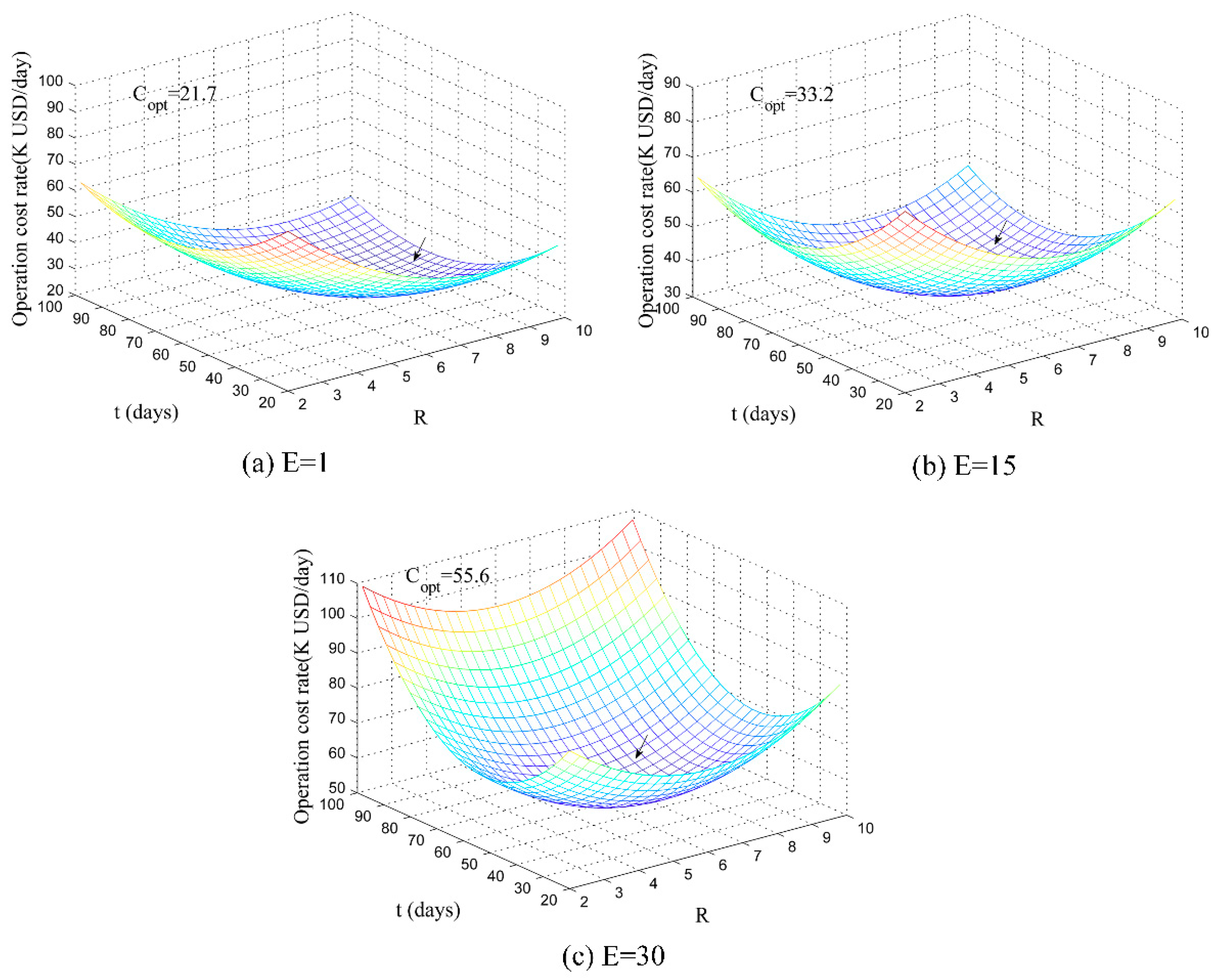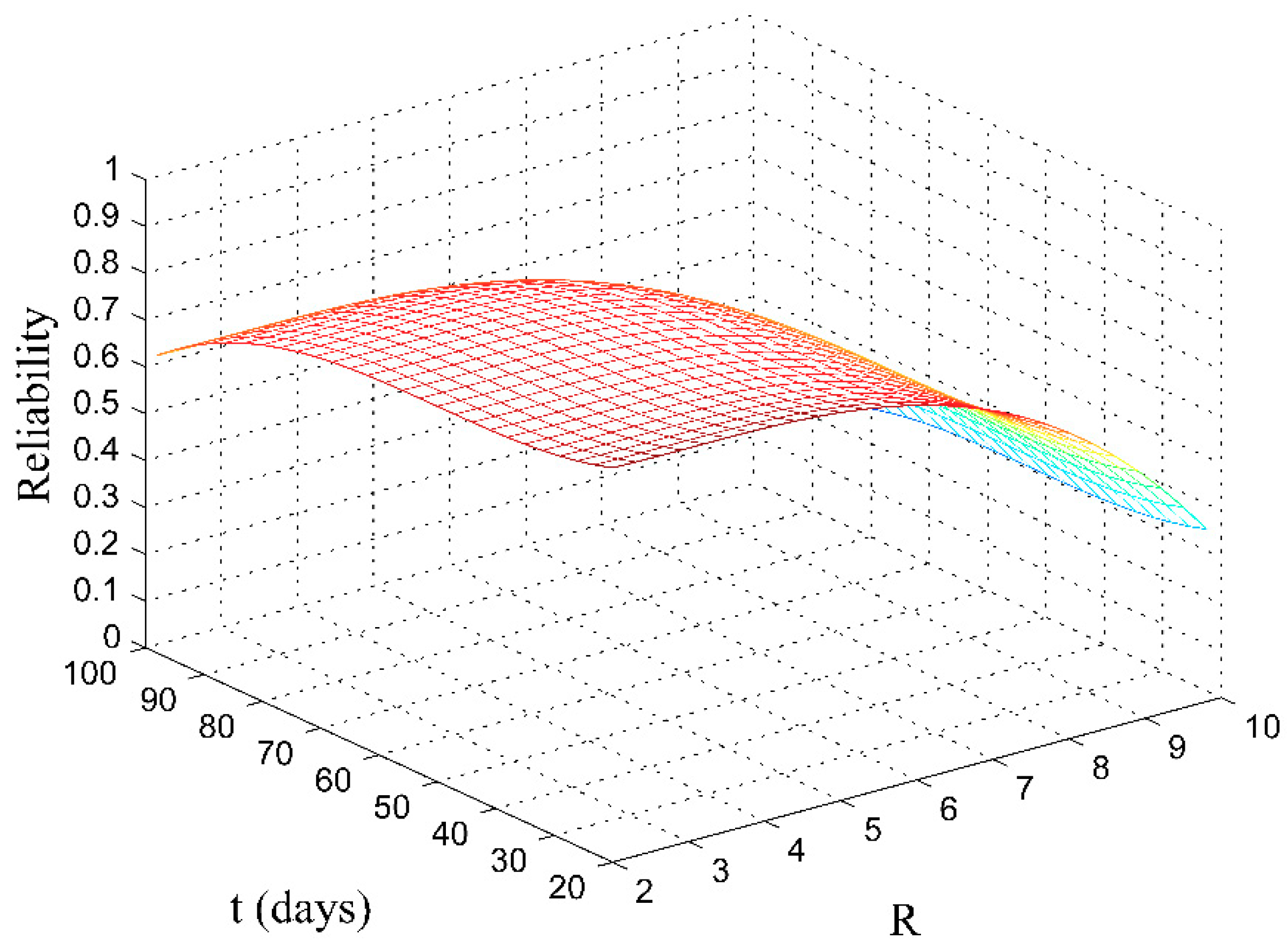Optimal Condition-Based Maintenance Strategy for Multi-Component Systems under Degradation Failures
Abstract
1. Introduction
- The first phase is called the normal working phase, where no obvious deviation from the normal operating state is observed. The end point of this phase is called the critical level of the system.
- The second phase is referred to as the failure delay period, since a defect may be initiated and progressively develop into a true failure. That means the system is in a defective stage but still working, and the point of this phase is referred to as failure level.
2. Model Development
2.1. System Description
- has independent increments.
- The random variable parameter follows an exponential probability density function.
2.2. Maintenance Model
- If the degradation level of a component increases rapidly and exceeds both the failure level and critical level at the monitoring epoch , that is , a CM action would be taken.
- If the degradation of components increases gradually and the degradation level is between and at the monitoring epoch , that is , a PM action would be taken.
- If the degradation level of components increases to below the critical level at the monitoring epoch , that is , maintenance action would not be taken until it reaches the critical level or failure level at next monitoring epoch.
2.3. Health Quantities Derivation
3. Maintenance Decision-Making
3.1. Maintenance Decision Based on Maximum LACR
3.2. Maintenance Decision Based on Maximum RUL
3.3. Optimal Solution for Monitoring Interval and Critical Level
4. Experimental Example
4.1. Application and Results
4.2. Influence of Failure Cost Rate on Optimal LACR
4.3. The Relationship between the RUL and Decision Variables
5. Conclusions and Future Work
Author Contributions
Funding
Conflicts of Interest
References
- Zhou, Y.; Sun, Y.; Mathew, J.; Wolff, R.; Ma, L. Latent degradation indicators estimation and prediction: A Monte Carlo approach. Mech. Syst. Signal Process. 2011, 25, 222–236. [Google Scholar] [CrossRef]
- Hajej, Z.; Rezg, N.; Gharbi, A. Quality issue in forecasting problem of production and maintenance policy for production unit. Int. J. Prod. Res. 2018, 56, 6147–6163. [Google Scholar] [CrossRef]
- Alsyouf, I. The role of maintenance in improving companies’ productivity and profitability. Int. J. Prod. Econ. 2007, 105, 70–78. [Google Scholar] [CrossRef]
- Duan, C.; Deng, C. Prognostics of health measures for machines with aging and dynamic cumulative damage. IEEE/ASME Trans. Mechatron. 2020, 1–12. [Google Scholar] [CrossRef]
- Do, P.; Voisin, A.; Levrat, E.; Iung, B. A proactive condition-based maintenance strategy with both perfect and imperfect maintenance actions. Reliab. Eng. Syst. Saf. 2015, 133, 22–32. [Google Scholar] [CrossRef]
- Hong, H.P.; Zhou, W.; Zhang, S.; Ye, W. Optimal condition-based maintenance decisions for systems with dependent stochastic degradation of components. Reliab. Eng. Syst. Saf. 2014, 121, 276–288. [Google Scholar] [CrossRef]
- Yanbin, C.; Bo, C. The Condition Based Maintenance Evaluation Model on On-post Vacuum Circuit Breaker. Syst. Eng. Procedia 2012, 4, 182–188. [Google Scholar] [CrossRef]
- Duan, C.; Deng, C.; Wang, B. Multi-phase sequential preventive maintenance scheduling for deteriorating repairable systems. J. Intell. Manuf. 2019, 30, 1779–1793. [Google Scholar] [CrossRef]
- El-Thalji, I.; Jantunen, E. On the Development of Condition Based Maintenance Strategy for Offshore Wind Farm: Requirement Elicitation Process. Energy Procedia 2012, 24, 328–339. [Google Scholar] [CrossRef]
- Tian, Z.; Jin, T.; Wu, B.; Ding, F. Condition based maintenance optimization for wind power generation systems under continuous monitoring. Renew. Energy 2011, 36, 1502–1509. [Google Scholar] [CrossRef]
- Duan, C.; Deng, C.; Gharaei, A.; Wu, J.; Wang, B. Selective maintenance scheduling under stochastic maintenance quality with multiple maintenance actions. Int. J. Prod. Res. 2018, 56, 7160–7178. [Google Scholar] [CrossRef]
- Duan, C.; Deng, C.; Gong, Q.; Wang, Y. Optimal failure mode-based preventive maintenance scheduling for a complex mechanical device. Int. J. Adv. Manuf. Technol. 2018, 95, 2717–2728. [Google Scholar] [CrossRef]
- Wang, W. A two-stage prognosis model in condition based maintenance. Eur. J. Oper. Res. 2007, 182, 1177–1187. [Google Scholar] [CrossRef]
- Zhang, M.; Ye, Z.; Xie, M. A condition-based maintenance strategy for heterogeneous populations. Comput. Ind. Eng. 2014, 77, 103–114. [Google Scholar] [CrossRef]
- Duan, C.; Makis, V.; Deng, C. A two-level bayesian early fault detection for mechanical equipment subject to dependent failure modes. Reliab. Eng. Syst. Saf. 2019, 193, 106676. [Google Scholar] [CrossRef]
- Wang, W. A model to determine the optimal critical level and the monitoring intervals in condition-based maintenance. Int. J. Prod. Res. 2000, 38, 1425–1436. [Google Scholar] [CrossRef]
- Sbihi, M.; Varnier, C. Single-machine scheduling with periodic and flexible periodic maintenance to minimize maximum tardiness. Comput. Ind. Eng. 2008, 55, 830–840. [Google Scholar] [CrossRef]
- Low, C.; Ji, M.; Hsu, C.-J.; Su, C.-T. Minimizing the makespan in a single machine scheduling problems with flexible and periodic maintenance. Appl. Math. Model. 2010, 34, 334–342. [Google Scholar] [CrossRef]
- Ji, M.; He, Y.; Cheng, T.C.E. Single-machine scheduling with periodic maintenance to minimize makespan. Comput. Oper. Res. 2007, 34, 1764–1770. [Google Scholar] [CrossRef]
- Zhu, Q.; Peng, H.; van Houtum, G.J. A condition-based maintenance policy for multi-component systems with a high maintenance setup cost. Or Spectr. 2015, 37, 1007–1035. [Google Scholar] [CrossRef]
- Papakonstantinou, K.G.; Shinozuka, M. Optimum inspection and maintenance policies for corroded structures using partially observable Markov decision processes and stochastic, physically based models. Probabilistic Eng. Mech. 2014, 37, 93–108. [Google Scholar] [CrossRef]
- Wang, W.; Zhao, F.; Peng, R. A preventive maintenance model with a two-level inspection policy based on a three-stage failure process. Reliab. Eng. Syst. Saf. 2014, 121, 207–220. [Google Scholar] [CrossRef]
- Duan, C.; Makis, V.; Deng, C. An integrated framework for health measures prediction and optimal maintenance policy for mechanical systems using a proportional hazards model. Mech. Syst. Signal Process. 2018, 111, 285–302. [Google Scholar] [CrossRef]
- Dieulle, L.; Bérenguer, C.; Grall, A.; Roussignol, M. Sequential condition-based maintenance scheduling for a deteriorating system. Eur. J. Oper. Res. 2003, 150, 451–461. [Google Scholar] [CrossRef]
- Duan, C.; Makis, V.; Deng, C. Optimal Bayesian early fault detection for CNC equipment using hidden semi-Markov process. Mech. Syst. Signal Process. 2019, 122, 290–306. [Google Scholar] [CrossRef]
- You, M.-Y.; Li, L.; Meng, G.; Ni, J. Two-Zone Proportional Hazard Model for Equipment Remaining Useful Life Prediction. J. Manuf. Sci. Eng. 2010, 132, 041008. [Google Scholar] [CrossRef]
- Dempster, A.P.; Laird, N.M.; Rubin, D.B. Maximum-likelihood estimation from incomplete data via the em algorithm (with discussion). J. R. Statal Soc. Ser. B Methodol. 1977, 39, 1–38. [Google Scholar]






| System Unit | Exponential Distribution Parameter | |
|---|---|---|
| Component 1 | 0.037 | 0.62 |
| Component 2 | 0.014 | 0.62 |
| Component 3 | 0.023 | 0.62 |
| Component 4 | 0.056 | 0.62 |
| Component 5 | 0.034 | 0.62 |
| Component 6 | 0.045 | 0.62 |
| System Unit | Failure Level | ||
|---|---|---|---|
| Component 1 | 1.2 | 4.1 | 9.7 |
| Component 2 | 0.5 | 1.7 | 9.7 |
| Component 3 | 3.7 | 11.2 | 9.7 |
| Component 4 | 1.5 | 5.2 | 9.7 |
| Component 5 | 0.8 | 1.9 | 9.7 |
| Component 6 | 0.3 | 1.0 | 9.7 |
| Component | 1 | 2 | 3 | 4 | 5 | 6 |
| Critical level | 6.8 | 6.4 | 7.7 | 6.5 | 7.8 | 6.3 |
| Component | 1 | 2 | 3 | 4 | 5 | 6 |
| Critical level | 6.2 | 6.1 | 7.2 | 6.3 | 7.6 | 6.1 |
© 2020 by the authors. Licensee MDPI, Basel, Switzerland. This article is an open access article distributed under the terms and conditions of the Creative Commons Attribution (CC BY) license (http://creativecommons.org/licenses/by/4.0/).
Share and Cite
Wang, K.; Deng, C.; Ding, L. Optimal Condition-Based Maintenance Strategy for Multi-Component Systems under Degradation Failures. Energies 2020, 13, 4346. https://doi.org/10.3390/en13174346
Wang K, Deng C, Ding L. Optimal Condition-Based Maintenance Strategy for Multi-Component Systems under Degradation Failures. Energies. 2020; 13(17):4346. https://doi.org/10.3390/en13174346
Chicago/Turabian StyleWang, Kui, Chao Deng, and Lili Ding. 2020. "Optimal Condition-Based Maintenance Strategy for Multi-Component Systems under Degradation Failures" Energies 13, no. 17: 4346. https://doi.org/10.3390/en13174346
APA StyleWang, K., Deng, C., & Ding, L. (2020). Optimal Condition-Based Maintenance Strategy for Multi-Component Systems under Degradation Failures. Energies, 13(17), 4346. https://doi.org/10.3390/en13174346




